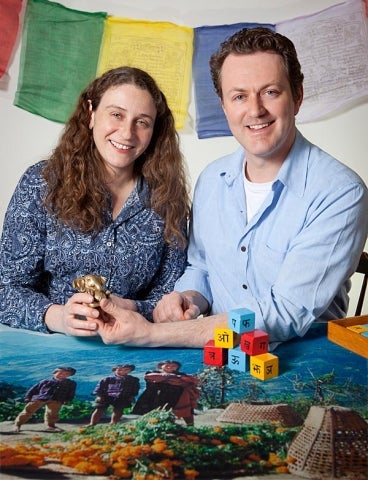Note: Yale School of the Environment (YSE) was formerly known as the Yale School of Forestry & Environmental Studies (F&ES). News articles and events posted prior to July 1, 2020 refer to the School's name at that time.
 <p class="p1"> Sara Shneiderman and Mark Turin hold a statue of Ganesha, a Hindu god. The children’s blocks are for learning the Devanagari script, in which Nepali and Hindi, as well as many other South Asian languages, are written. Buddhist prayer flags hang in the background.</p>
<p class="p1"> Sara Shneiderman and Mark Turin hold a statue of Ganesha, a Hindu god. The children’s blocks are for learning the Devanagari script, in which Nepali and Hindi, as well as many other South Asian languages, are written. Buddhist prayer flags hang in the background.</p>
The Himalayan Initiative made its first hire when it was still just a vague idea in Shivi Sivaramakrishnan’s head. In 2009 he helped recruit Sara Shneiderman, then a postdoc at Cambridge University, as an assistant professor of anthropology—“a very unusual hiring,” says Shneiderman, because “the Himalayas are typically defined as peripheral” to South Asian Studies. She spent a year finishing up her fellowship and has now joined the faculty at Yale. Her husband, Mark Turin, an expert on Himalayan languages, has also come to Yale on a shared research appointment with Cambridge.
Both were working in Nepal in the mid-1990s when they met while traveling with friends. Almost the first thing they talked about was the celebrated “Family of Man” photography exhibition organized by Edward Steichen in the 1950s. Shneiderman’s uncle, a co-founder of the Magnum photo agency, had contributed work to the show. So had Turin’s grandfather, who had been a photographer in the Dutch Resistance.
Both were working in Nepal in the mid-1990s when they met while traveling with friends. Almost the first thing they talked about was the celebrated “Family of Man” photography exhibition organized by Edward Steichen in the 1950s. Shneiderman’s uncle, a co-founder of the Magnum photo agency, had contributed work to the show. So had Turin’s grandfather, who had been a photographer in the Dutch Resistance.
Shneiderman was planning to begin grad school then, and Turin was looking around for a doctoral project in linguistics. Together they decided to focus on the Thangmi, a community of about 35,000 people, many of whom migrate on an annual circuit through three Himalayan countries, from their base in the hill districts of eastern Nepal to the Indian states of West Bengal and Sikkim and into border areas of China’s Tibet Autonomous Region. The Thangmi presented themselves “as people without a culture,” but the two researchers gradually learned otherwise.
Turin says it took “the best part of three years to learn Thangmi to a level sophisticated enough to tell a joke and another year to be able to tell a joke that was actually funny.” But he adds that “whole conceptual, social and ecological worlds open up when you learn to speak and come to understand languages vastly different from your own.” Natural resource scientists who must frequently “parachute” into problem areas often cannot afford that luxury. But it’s the sort of thing where collaboration with social scientists can produce useful results: “Perhaps most important to a conservation and biodiversity readership, every language encodes a particular subset of fragile human knowledge about agriculture, botany, medicine and ecology.”
Turin says it took “the best part of three years to learn Thangmi to a level sophisticated enough to tell a joke and another year to be able to tell a joke that was actually funny.” But he adds that “whole conceptual, social and ecological worlds open up when you learn to speak and come to understand languages vastly different from your own.” Natural resource scientists who must frequently “parachute” into problem areas often cannot afford that luxury. But it’s the sort of thing where collaboration with social scientists can produce useful results: “Perhaps most important to a conservation and biodiversity readership, every language encodes a particular subset of fragile human knowledge about agriculture, botany, medicine and ecology.”
Turin’s alarm at the rapid disappearance of languages—and the knowledge embedded within them—recently led him to create the World Oral Literature Project, an effort to document endangered languages before they become extinct. He also directs Digital Himalaya, a rapidly expanding archive of film, photographs, audio recordings, maps and rare publications. Both collections are based jointly at Cambridge and Yale and will serve as key resources for the Himalayan Initiative. Both websites are also being heavily used by people within the Himalayas themselves, who can now access much of their own documented history, often for the first time.
Published
January 1, 2000
